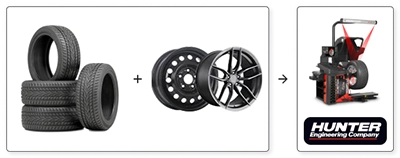This year I'm buying winter tires, all-season or all-weather tires?

As the days get shorter, the temperatures drop, and patches of ice appear on the roads overnight, you have a big question: what kind of tires should I buy?
You first need to know the difference between winter tires (or snow tires), all-season tires and winter-rated all-season tires.
The main differences between all-season tires, all-season tires and winter tires are the rubber compound used in the tire's construction, the tread pattern, the sipes for traction and the water and snow drainage.
All-season tires
All-season tires are designed to provide a smooth, quiet ride in most weather conditions, except for deep snow, icy roads and cold days.
The rubber in the all-season tire begins to harden as soon as the temperature reaches 7°C, and the phenomenon accelerates sharply at -7°C.
Many all-season tires perform well in the rain and on open roads all year round. Again, while a set of all-season tires can provide some traction in light snow, they are not designed for deep snow, ice and cold.
The most significant advantage of the all-season tire is that it can be used year-round in areas where snow is very infrequent, without changing it, eliminating the need to store an extra set of tires.
This makes them ideal for vehicle owners who live in a region with a milder winter climate.
Winter tire features

The winter tire not only retains its elasticity longer, but its tread is also more aggressive in adhering to the various surfaces of our roads during the winter season while evacuating as much snow and slush as possible. Even on dry asphalt, when the temperature is below freezing, the winter tire is superior and safer because it maintains its elasticity.
Winter tires are marked on their sidewall with a pictogram of a snowflake in a three-peaked mountain. This symbol guarantees that the tires have passed the government-regulated grip test. Tires marked "M+S" (for mud and snow) are not winter tires.
Winter tires allow us to drive with good traction and ensure that the vehicle remains stable while maintaining its trajectory in turns.
Braking distances on snow and ice are shorter. At a temperature of -7° and at 80 km/h, the braking distance of a summer tire compared to a winter tire is 42 meters longer (Source: Goodyear and Michelin).
From 20 to 90 km/h with a temperature of 5°C on a wet road, the average braking distance of a winter tire compared to a summer tire is about 7% shorter.
The winter tire has more notches than a four-season tire. The biting edges of the deep, wide, serrated tread of snow tires maintain traction in the most challenging conditions.
A stud winter tire can add even more traction when driving on icy roads.
It is important to remember that the use of winter tires extends the life of summer or all-season tires. In Canada, winter tires are still the best option for your vehicle.
It is important to note that since 2014, all passenger vehicles registered in Quebec must be equipped with winter tires bearing the pictogram of a snowflake in a three-peaked mountain.
All-season or four-season tires approved for winter use
In recent years, we have been able to purchase a wider variety of winter-rated all-season tires. These "all-purpose" tires are designed for year-round use. The problem is that their tread is stiffer than a conventional winter tire and, therefore, less suitable for icy surfaces.
The grip on ice is inferior to that of a winter tire.
If you live on the outskirts of a large city, in a rural area or in a region where there is a lot of snowfall during the winter, we recommend that you do not buy winter-approved tires.
But if you live in an urban area where snow and cold are rare and have very few roads to drive on, you may want to consider winter tires.
Whatever your choice of tires, it is essential to have the right tires, safe and adapted to your vehicle.


